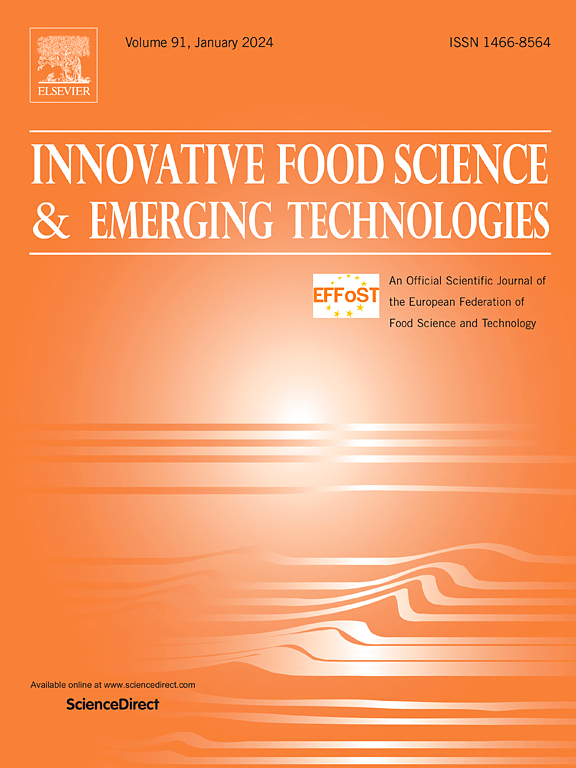Growth/no-growth boundary of superdormant Clostridium perfringens spores under synergic treatment of heat and hydrostatic pressure: Modeling and evaluation
IF 6.3
1区 农林科学
Q1 FOOD SCIENCE & TECHNOLOGY
Innovative Food Science & Emerging Technologies
Pub Date : 2025-01-27
DOI:10.1016/j.ifset.2025.103936
引用次数: 0
Abstract
Clostridium perfringens spores exhibit substantial resistance to conventional sterilization methods, posing a significant food safety challenge due to potential toxin production. Although heat and hydrostatic pressure treatments can effectively inactivate most spores, superdormant (SD) spores often persist. This study investigated the effects of common additives, including sodium chloride (NaCl, 0–4 %), acetic acid (CH₃COOH, 0–0.16 %), and allyl isothiocyanate (AITC, 0–0.04 %) on the germination and outgrowth of SD spores, using dormant (D) spores as a control. Logistic regression was used to develop growth/no-growth boundary models for both spore types. The results demonstrated that increasing NaCl, CH₃COOH, and AITC concentrations significantly inhibited the growth of both D and SD spores (p < 0.05). Notably, SD spores exhibited heightened sensitivity and were inhibited at lower concentrations than D spores. The antimicrobial effects of NaCl, CH₃COOH, and AITC on spore growth in chicken meat were experimentally validated and compared with model predictions. While minor discrepancies were observed due to variations in the growth medium, the experimental results generally agreed strongly with the model's predictions. These growth/no-growth boundary models quantitatively assess the inhibitory effects of NaCl, CH₃COOH, and AITC on SD spores under synergic treatment of heat and hydrostatic pressure, providing a critical foundation for optimizing antimicrobial strategies to improve food safety in cooked meat products.

热和静水压力协同作用下超休眠产气荚膜梭菌孢子的生长/不生长边界:建模和评价
产气荚膜梭菌孢子对传统的灭菌方法有很大的抵抗力,由于潜在的毒素产生,对食品安全构成了重大挑战。虽然加热和静水压力处理可以有效地灭活大多数孢子,但超休眠孢子通常会持续存在。本研究以休眠(D)孢子为对照,研究了常见添加剂氯化钠(NaCl, 0 - 4%)、乙酸(CH₃COOH, 0 - 0.16%)和异硫氰酸丙烯酯(AITC, 0 - 0.04%)对SD孢子萌发和生长的影响。采用Logistic回归建立了两种孢子类型的生长/无生长边界模型。结果表明,NaCl、CH₃COOH和AITC浓度的增加显著抑制了D和SD孢子的生长(p <;0.05)。值得注意的是,SD孢子比D孢子表现出更高的敏感性,并且在较低浓度下受到抑制。通过实验验证了NaCl、CH₃COOH和AITC对鸡肉孢子生长的抑菌作用,并与模型预测结果进行了比较。虽然由于生长介质的变化而观察到微小的差异,但实验结果总体上与模型的预测非常一致。这些生长/不生长边界模型定量评价了NaCl、CH₃COOH和AITC在热和静水压力协同作用下对SD孢子的抑制作用,为优化抗菌策略以提高熟肉制品的食品安全性提供了重要依据。
本文章由计算机程序翻译,如有差异,请以英文原文为准。
求助全文
约1分钟内获得全文
求助全文
来源期刊
CiteScore
12.00
自引率
6.10%
发文量
259
审稿时长
25 days
期刊介绍:
Innovative Food Science and Emerging Technologies (IFSET) aims to provide the highest quality original contributions and few, mainly upon invitation, reviews on and highly innovative developments in food science and emerging food process technologies. The significance of the results either for the science community or for industrial R&D groups must be specified. Papers submitted must be of highest scientific quality and only those advancing current scientific knowledge and understanding or with technical relevance will be considered.

 求助内容:
求助内容: 应助结果提醒方式:
应助结果提醒方式:


